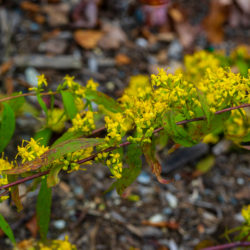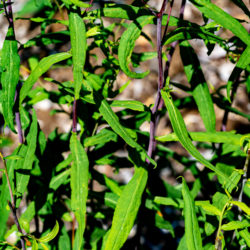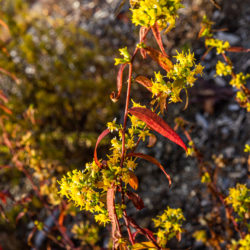Etymology
Solidago is from the Latin words solidus (whole) and ago (to make) in reference to the medicinal healing properties of some plants of this species; caesia is Latin for light blue.
Native Habitat
Forest edges, forests and woodlands.
Garden Uses
This is an interesting goldenrod for native plant gardens, open woodland gardens, borders, wild gardens, cottage gardens, meadows or butterfly gardens. Expect it to become taller and more full in sunnier locations.
Overview
Blue stemmed goldenrod is a perennial woodland species that tolerates poor, dry soils and shade, but is most robust in full sun with average, dry to medium, well-drained soils. This species, with graceful arching stems, is primarily clump-forming and does not spread aggressively, though it does reseed readily.
Leaves and Stems
The leaves are lance-shaped, medium green, 2 - 5" long, toothed, tapered and sharply pointed. The stems are green and smooth when young and become purplish with age -- they are covered with a silvery-white waxy bloom that can be rubbed off.
Flowers
Flowers appear in a series of loose clusters in the leaf axils (the area where the leaf joins the stem) along the length of the stems, with the clusters at the top being the largest. The flowers are tiny (1/8”), yellow and daisy-like with 3-5 rays per head.
Fruit/Seed
Fertile flowers mature into small oblong achenes (dry closed fruits that each contain a single seed). The achenes are attached to small fluffy hairs that allow the seed to be distributed by the wind.
Wildlife Associates
Blue-stemmed goldenrod attracts butterflies, songbirds and other pollinators and is of special value to native bees. It is somewhat unpalatable to deer and rabbits.
Propagation
May be easily grown from seed.
Ethnobotanical Uses
None found.
Garden Location
Library Garden (see garden map)
Anecdotal Information
Goldenrods have been wrongfully accused of causing hay fever which is actually an allergic reaction to wind-borne pollen from other plants such as ragweed.
Sources
Lady Bird Johnson Wildflower Center
Plant Profile by Kathy Kling



